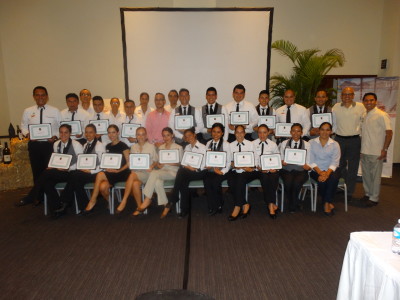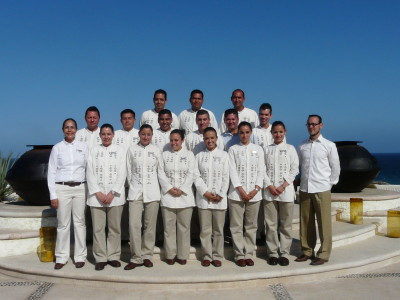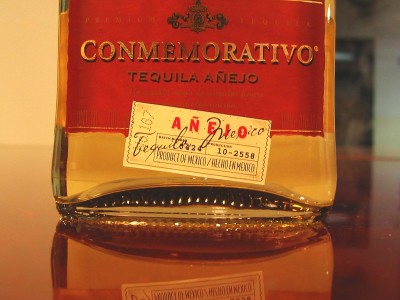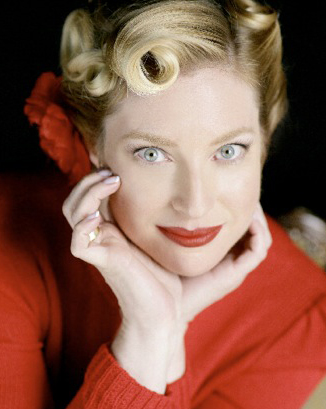
The Modern Butlers’ Journal volume 10, issue 8
International Institute of Modern Butlers
 Message from the Chairman
Message from the Chairman
For the second time in a year, we bumped into fellow butler trainers on our flight out of the Maldives a few weeks back. Either there are many more of us than we realized, or we are all concentrated in the Maldives, or it was just a happy coincidence. Our profession seems to be doing well overall in terms of demand for butler and household management service, as well as having a good image as a result of everything from Downton Abbey to plain old doing our jobs in a low key manner and following the code of conduct expected of the profession. A simple example was Mr. Prem Rao’s lecture on the profession to a university group visiting London recently, the letter of thanks for which is just below. Long may it all continue!
Letters to the Editor
“I wanted to say thanks to all for arranging for Prem to speak to our group on the profession in London. He was so wonderful! When we left the building and into the next day, our group was talking about the many things he shared with us. We are coming back next year and I so wish we could book him again—he will be the first person we contact for our groups.” SL
Butlers in the Media
It seems hotels and others are still finding ways to capitalize on the butler concept. A new title has found a way to combine two earlier iterations—Poolside Technology Butlers—“providing cell phone charging and screen cleaning assistance for connected guests.”
One hotel in not-so-sunny Jersey is outdoing The Ritz Carlton on South Beach with their Sunshine Butler, but both come out ahead of the digital Beach Butler that seems to have squeezed a live person out of the picture entirely in one hotel chain.
Then there is The Culinary Butler, offering consulting services for the culinary, bakery, restaurant professional and new food business owner.
For those with pets, there is the inevitable Dog Butler, and for those who would like a master contacts database to organize their lives, the Digital Butler is probably just the right thing, according to the WSJ.
One nobel old chain has finally admitted the arrival of the 21st Century by creating the position of IT Butler.
Has anyone heard of a Butler Choker? A grim visual, to be sure, but it is an ultra-cheap necklace sporting a peppermint-look-alike butler as its centerpiece. Extraordinary what some people will conceive. Not so extraordinary is the TextBook Butler at a university.
Butler Tray Tables from Bombay are probably more recognizable, being simply breakfast-in-bed trays.
Marginally more useful is The Stock Butler, a web site offering advice on how to manage one’s stocks.
Moving on, NBC reports on the obvious.
On a somber note, the headline Butler crushed to death by service lift in stately home leaves too much to the imagination as to how this tragedy happened. It seems it was an old elevator and probably should have been serviced more than it was. Still, that is not the way any of us would like to go, and we send our heartfelt condolences to those who knew the poor man.
Finally, the butler profession is making inroads into more sectors of society, with Mr. Charles MacPherson training Ford personnel in dealerships in Canada, and Mr. Robert Wennekes setting up a branch of TIBA in China.
Butler Training



Executive Protection & Security
by Baron James Shortt
Winter sports with your VIP
Believe it or not, a Russian Oligarch arrived in Switzerland (Klosters) with ten bodyguards and not one of them could ski. The trip had been planned for weeks, so the executive protection team knew what it would entail and not one of the executive protection team fessed up prior to departure that they could not ski. So, in Klosters, with 10 snowmen.
Winter sports covers alpine events such as downhill skiing, cross country skiing, toboggan, snowboarding, luge, dog- and reindeer sleigh adventures and, one of my favorites – the snowmobile. Each sport has its own set of skill requirements and experience. Truly, just about anyone can drive a snowmobile after a few hours practice, but it takes a good deal more experience to operate one at full throttle up, down and across steep and uneven terrain. It takes even more information and experience not to cause a landslide and how to attempt to avoid the consequences of a landside if one does occur. It’s similar to skiing; some people can ski all day long on a groomed slope, but what if the charge wishes to helicopter-ski in deep powder? These are two very different types of skiing.
Equipment for alpine events is specialized, expensive and bulky. Thus you have to either haul or hire: we choose to hire. The equipment you can procure through a hiring company is usually of good quality and recent vintage. It also gives a good deal of flexibility that hauling all your own equipment does not. With hiring, you can change your equipment depending on the specific snow conditions of a particular day; you can swop and change between using shorter or longer skis.
Do not just choose a vehicle. If you are not hiring equipment, you might be able to find a smaller option, but it will still have to have room to haul the heavy winter gear. If you are hauling, you will need racks, or a trailer or maybe even a supply vehicle to assist.
The advance party in these situations can make all the difference in the world. Even if the VIP has a small group, secure drop off spots close to the lodge can be arranged with some polite requests. If you are hiring equipment: sizes and weight of all parties can be transmitted in advance so that the equipment is waiting on their arrival. Ideally, the deployable portion of the EP (Executive Protection) team should already be geared up and waiting for the VIP’s arrival. Lift tickets, hotel rooms and “special events” can all be booked/arranged in advance and secured, so arrival is literally just leaving the vehicles, putting on ski’s, attaching the lift ticket and immediately starting to have fun.
Advance parties can also find out where the “action” is as well as what else may be occurring in the town. One charge was amused (although his companion was not!) when they spent a weekend skiing at Crested Butte in Montana. There was an unofficial nude ski event that day to raise money for breast cancer. Another unexpected surprise came when the slopes had been opened for both skiers and snow boarders at the end of the season, which caused no end of chaos on the slopes.
Safety issues
Avalanches can and do happen every year. Most avalanches occur when the slope is between 30° to 45° (50° to 60° in maritime climates). But one can often see beforehand where an avalanche can occur, simply by looking at the mountain and knowing what to look for. Pay attention to areas that are steep and devoid of trees. Avalanches can be so powerful that they will rip all flora from a path in front of them. Such a quick analysis is obviously not foolproof by any stretch of the imagination, so it is best to check with the local ski patrol to see what and where the dangers may be. Also, in some locations, avalanches are common and explosives are used to trigger them before they occur naturally. Much like a prescribed burn in a forest with a build-up of fuels, a prescribed avalanche with a build-up of snow lessens the dangers of an unexpected and catastrophic event. But this raises the issue of unexploded ordinance in these regions. A cure to one risk that then leaves a legacy risk.
EP should be ready for avalanche disasters and equip themselves as well as their charges with avalanche alert beacons and portable search poles. For as little as 200€ per alert beacon and 10€ for poles, not having several is a crime, not to mention a danger to one’s life.
Some resorts are located in places where local hostilities still simmer. An Oligarch would be unwise to ski without serious protection at eastern European resorts. Sniper positions in an alpine environment are all too easy to find. So how does the EP team deny the sniper a target? One is to have all matching ski and winter outerwear. Another is to rotate slopes randomly and also to keep perimeter between the charge and the rest of the environment. Position security down hill, side hill and up hill, thus creating a circle of protection. It is also wise to rotate the charge’s position. It would be unwise to have them always at the center, much like a bulls eye on a target.
Additional safety gear should include (depending on environment) snow shoes, blue ice skates, artic ski shoes, snow axes, poles for walking, emergency space blankets, a quick shelter, and the knowledge on how to use all of this equipment. Being prepared is great but the EP team needs real skills.
Snowmobile and rescue sled
Other issues to consider are the positioning of snowmobiles for evacuation, a satellite phone with helicopters standing by, just in case. All things being equal, these winter tools are a must to have at the ready.
As for the EP team, they need to remember the following for themselves: lip balm, moisturizers, high factor sun cream, sunglasses and good goggles, a first aid kit, knowledge of local shelters, current weather and forecasts. Some of the group should also participate in skiing, or snowmobiling with helmets, and use knee and elbow protection. This may also be advisable for the charge. But, if they do not accept it, some of the team should also participate without this protection, so as not to appear too different.
Baron Shortt is the Executive Director of the IBA
 Let’s Talk about Spirits, Part 6
Let’s Talk about Spirits, Part 6
by Amer Vargas
Tequila, Part 2 of 2
Last month, we left the discussion of tequila after its double (sometimes triple) distillation, with an alcohol level of 55% minimum.

Following this process, the tequila can be bottled as white tequila, allowed to gain some aromas and color from wooden barrels, combined with other tequilas, or aged and matured for months or years in order to produce more delicate flavors.
Depending on the amount of sugar in the agave used for the production of Tequila, it is classified as:
100% from Agave means that all sugars come from the typical Agave Tequilana plant and can only be bottled in a factory controlled by an Authorized Producer.
Tequila is any product that has a minimum of 51% of sugars coming from the agave plant. The rest of the sugars come from other ingredients like sugar, brown powdered sugar, glucose, fructose, or molasses. This Tequila can be bottled by other than Authorized Producers, as long as they abide by the established requirements of the Norma Oficial Mexicana para el Tequila (Official Mexican Rules Governing Tequila).
Depending on the characteristics acquired during the brewing, Tequila is classified as:

Blanco o Plata (White or Silver): Almost colorless and a completely transparent drink that has undergone an aging of two or less months.
Joven u Oro (Young or Gold): Produced by mixing White Tequila with Reposado, Añejo or Extra Añejo (see below), or by mixing the Tequila with other sugars, resulting in golden tonalities.
Reposado (Rested): Aged between two months and a year in small or large oak barrels, resulting in a darker coloration.

Añejo (Aged): Aged between one and three years in small oak barrels, presenting a darker color than Reposado.
Extra añejo (Extra aged): Aged for a minimum of three years in small oak barrels, this is the darkest of the existing Tequilas.
Whilst Blanco or Plata and 100% Tequila have harsher and more cutting flavors, aged Tequilas present more complex, smoother and subtler tastes, softening the roughness of the alcohol.
So, surround yourself with your best friends, help yourselves to a nice Extra Añejo and…Cheers!
Mr. Vargas is the Institute’s Vice President for Europe and can be contacted via AmerVargas at modernbutlers.com
Of Butlers and Roses, Part 4 of 20
The Arrangement
by GJ dePillis
Let’s fast forward briefly to the day when you have many beautiful roses and flowers to brighten the estate for employers and visitors alike.
During the summer months, particularly, so many life changing events can happen: weddings and graduations, fund-raising events, galas, vacations and in June, of course, there is Father’s Day.
One unusual idea that James Tobin, Majordomo to a private family in Vancouver, Canada suggested, is to make Father’s Day personal by decorating the dinner table with Mr. Employer’s ties, laying them out as if they were arrows pointing to a center piece, which could contain a manly bouquet of blossoms.
David Austin experts suggested another motif for butlers to use on this occasion: find a rugged container or something with texture (being careful not to snag any of the delicate fabric of the ties, of course). Go into the estate’s forest and see if there is some textured bark that could be used to wrap around a simple vase. If one doesn’t have a forest, then textured paper could substitute.
Obtain a form in which to stick the stems.
The roses need to be welcoming and that means removing the thorns, which can be done with a thorn remover.
Then carefully select some of your other smaller flowers as background.

You can arrange them symmetrically, such as these deep red Darcy roses, or asymmetrically, as with the Juliet roses (see below), which casually cascade down a set of tightly cupped rose steps.
The Darcy red roses are perfect for softening a rough wall, as shown in the photo.

The asymmetrical look can be achieved by placing the tallest rose first, establishing the focal point. Then plan out where you want the eye to travel. If down, then make sure the top of each bloom steps down uniformly. After this, feel free to add in the filler flowers to create a more “wild flower” feel to it. This will make the arrangement more rugged.
Here are some suggestions for filler flowers: Ruscus, pitosporum, symphoricarpus, ivy, viburnum, hypericum, rose hips, thlapsi, Brunia and berzelia, seeded eucalyptus.
To create a more structured arrangement, it is suggested to use the following filler flowers: Mini-hydrangeas, small hydrangeas, Anemone, bouvardia, freesia, lavender, mints, and phlox.
For more vertical arrangements, augment the bouquet with delphinium, larkspur, various branches, or curly willow.
Ms. dePillis is a freelance contributor to the Journal who is based on the West Coast of the United States. She can be reached via depillis at gmail.com
 Consulting the Silver Expert
Consulting the Silver Expert
by Jeffrey Herman
Q: Should one remove monograms?
A: Monograms on silver are part of the object’s history and should not be removed for this reason. Museums use monograms to help trace an object’s provenance. Beautiful engraving is a work of art—an art form quickly disappearing. Sadly, most antique dealers indiscriminately remove monograms to make the object more saleable.
Having said this, if a customer insists on having the engraving removed, it can be eradicated and I would rather remove the monogram myself than have the object brought to someone less skilled. I have no reservations in removing machine engraving from mass-produced flatware. Keep in mind, though, that if a monogram is deeply engraved on the bottom of a thin tray, for example, the results may not be desirable, for any weight placed on that area could possibly produce a dent.
Mr. Herman continues to offer his services to our readers for any questions you may have about the care of silver. Either call him at (800) 339-0417 (USA) or email jeff at hermansilver.com
The Institute is dedicated to raising service standards by broadly disseminating the mindset and skills of that time-honored, quintessential service provider, the British Butler, adapted to the needs of modern employers and guests in staffed homes, luxury hotels, resort, spas, retirement communities, jets, yachts, & cruise ships around the world.


